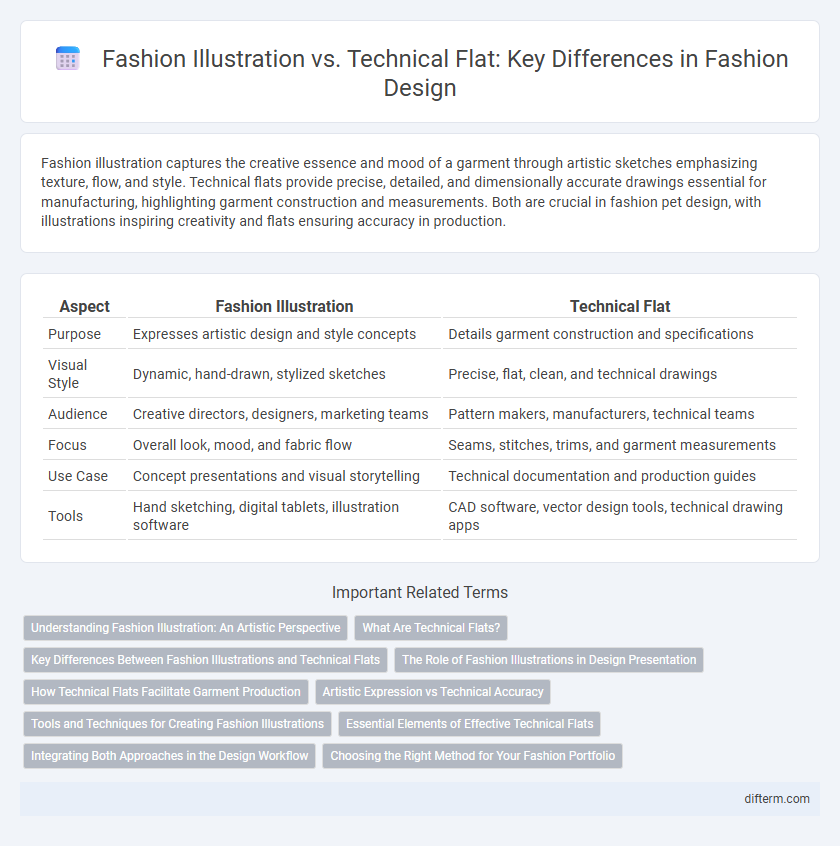Fashion illustration captures the creative essence and mood of a garment through artistic sketches emphasizing texture, flow, and style. Technical flats provide precise, detailed, and dimensionally accurate drawings essential for manufacturing, highlighting garment construction and measurements. Both are crucial in fashion pet design, with illustrations inspiring creativity and flats ensuring accuracy in production.
Table of Comparison
| Aspect | Fashion Illustration | Technical Flat |
|---|---|---|
| Purpose | Expresses artistic design and style concepts | Details garment construction and specifications |
| Visual Style | Dynamic, hand-drawn, stylized sketches | Precise, flat, clean, and technical drawings |
| Audience | Creative directors, designers, marketing teams | Pattern makers, manufacturers, technical teams |
| Focus | Overall look, mood, and fabric flow | Seams, stitches, trims, and garment measurements |
| Use Case | Concept presentations and visual storytelling | Technical documentation and production guides |
| Tools | Hand sketching, digital tablets, illustration software | CAD software, vector design tools, technical drawing apps |
Understanding Fashion Illustration: An Artistic Perspective
Fashion illustration captures the essence of clothing through expressive sketches that emphasize movement, mood, and style, serving as a creative blueprint for designers. Unlike technical flats, which provide precise garment specifications and measurements for production, fashion illustrations prioritize artistic interpretation and visual storytelling. This artistic perspective helps designers communicate the emotional and aesthetic qualities of their collections to clients and collaborators.
What Are Technical Flats?
Technical flats are detailed, two-dimensional drawings used in fashion design to accurately represent garment construction, including seams, stitches, and proportions. Unlike fashion illustrations, which emphasize artistic expression and aesthetics, technical flats provide precise specifications necessary for pattern making and production. These flats serve as essential communication tools between designers, manufacturers, and production teams, ensuring the garment is created exactly as intended.
Key Differences Between Fashion Illustrations and Technical Flats
Fashion illustrations emphasize artistic expression, showcasing the design's mood, texture, and movement through stylized drawing techniques and vibrant colors. In contrast, technical flats provide precise, detailed, and standardized line drawings that communicate exact garment construction, fit, and specifications to manufacturers. The key difference lies in fashion illustrations inspiring creativity and vision, whereas technical flats serve as practical blueprints for production accuracy.
The Role of Fashion Illustrations in Design Presentation
Fashion illustrations play a crucial role in design presentation by conveying the artistic vision and mood of a collection through expressive, hand-drawn sketches that highlight fabric textures, colors, and movement. Unlike technical flats, which emphasize precise garment construction and measurements, fashion illustrations offer an emotional and creative perspective that helps communicate the designer's concept to clients and stakeholders. These visual narratives inspire and engage audiences, bridging the gap between initial ideas and technical execution.
How Technical Flats Facilitate Garment Production
Technical flats provide precise, detailed drawings of garments with accurate measurements and construction details, essential for clear communication between designers and manufacturers. These illustrations include stitching lines, seam placements, and component parts, enabling efficient pattern-making and production planning. By standardizing garment specifications, technical flats reduce errors, streamline sample creation, and accelerate the overall development process.
Artistic Expression vs Technical Accuracy
Fashion illustration emphasizes artistic expression, capturing the mood, movement, and style of a garment through fluid lines and creative detailing. Technical flats prioritize technical accuracy, providing precise, scaled drawings with exact measurements, stitching, and construction details essential for production. Both play crucial roles in fashion design, balancing creativity with functionality to bring ideas from concept to reality.
Tools and Techniques for Creating Fashion Illustrations
Fashion illustration relies on traditional tools such as markers, watercolors, and pencils to convey artistic expression and garment texture, while digital software like Adobe Illustrator and Clo3D enables precise technical flat drawings for pattern making and garment construction. Techniques in fashion illustration emphasize fluidity and creativity through hand-drawn sketches, whereas technical flats require accuracy with vector lines and standardized symbols for conveyance of design details. Mastery of both approaches involves combining manual sketching skills and digital proficiency to effectively communicate design concepts within the fashion industry.
Essential Elements of Effective Technical Flats
Effective technical flats require precise line work, accurate scale, and clear depiction of construction details such as seams, stitches, and hardware. They prioritize functional representation over artistic expression to communicate garment specifications to manufacturers. Consistent use of standardized symbols and labels enhances clarity and reduces errors during production.
Integrating Both Approaches in the Design Workflow
Fashion illustration captures the artistic vision and emotional appeal of a design through expressive sketches, while technical flats provide precise, detailed, and standardized garment specifications essential for production. Integrating both approaches optimizes the design workflow by combining creativity with technical accuracy, ensuring clear communication between designers, pattern makers, and manufacturers. This fusion accelerates the transition from concept to prototype, enhancing efficiency and reducing errors in the development process.
Choosing the Right Method for Your Fashion Portfolio
Fashion illustration captures creative expression and artistry through dynamic sketches that highlight design vision and style. Technical flats provide precise, detailed, and standardized drawings essential for communicating construction and garment specifications to manufacturers. Selecting the right method depends on whether your portfolio aims to showcase creativity and aesthetics or emphasize accuracy and technical details for production.
Fashion illustration vs Technical flat Infographic

 difterm.com
difterm.com